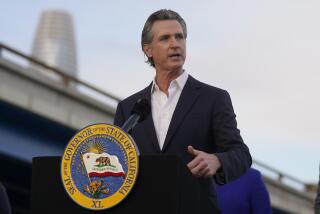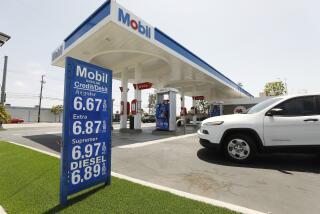Fuel for Change
It’s Monday, and Lyle Sparks is in a Costa Mesa service station feeding gasoline to an RV the size of a hotel lobby. He and his wife have driven from Washington state on the first leg of a tour of America.
But as he watches the gas pump numbers whirl at light speed, he says his plans might change. “I think we’ll buy a house here and stay,” he says. “It’ll be cheaper than driving back.”
But seriously, says Sparks, he will continue his trip. “We’ve planned it for years, and we’re not going to stop now,” he says. Besides, the gas he is pumping at $1.55 is not the most expensive he’s seen in California. In fact, it isn’t even the most expensive in Orange County.
On Friday, a Tustin woman topped up her family van at $1.69 a gallon for a trip to San Diego. She returned Sunday to find gas selling for $1.72 at the same station.
That was modest compared with increases when the prices first started rising. Customers reported that one station’s prices jumped 30 cents a gallon in one day.
People are beginning to react.
Commuters on the Santa Ana-to-Los Angeles Metrolink trains report that cars are more crowded. Metrolink says ridership on the route is up almost 13%.
The Orange County Transportation Authority, which operates local buses, says its buses are definitely more crowded, “but we don’t have the numbers yet,” says CEO Stan Oftelie. “Of course, our fuel costs are up, too, as much as 31%.”
Still, some are not yet worried.
At Traveland U.S.A. in Irvine, where 15 RV dealerships and 10 other parts and service companies specialize in gas-guzzling RVs, sales staff reported no drop in business.
“If they drive their RV 5,000 miles a year, it would cost them maybe $200 a year more in gasoline. That’s not even the cost of an awning,” says Dave Farwell, general manager.
There are those, however, who are ready to revolt. Myrna Lightstone, for one, isn’t taking it sitting down.
In fact, sitting in the sofa-like leather seats of her champagne color Cadillac is her least favorite thing to do since prices for super unleaded soared to $1.70 at the local Mobil station.
The Encino-based Realtor wants to start a “gas rebellion” in which everyone stays home and drives nowhere for at least one protest day. Short of that, she’s changing her daily routine. Lightstone says she used to spend many hours each week “driving around to preview properties for my clients.” No more. Instead of visiting all the houses, she consults pictures on her home computer.
Avimael Rico of Canoga Park, a construction worker, has no such options. “If I don’t drive, I don’t work and I don’t earn money.” His “business partner” is a big Ford truck, which used to top off at $25 a tank. Now that much pays for less than three-quarters of a tank, he says. People who must drive will deny themselves food before they’ll let their rigs go thirsty, he says.
*
At this point in the gas price drama, most Southern Californians are only talking about the extra cost. “Great flocks of people have not abandoned the auto for the train,” says Amtrak’s Dawn Soper. But it’s clear that many are quietly rearranging their personal lives and their work commute to save money. Ridership on MetroLink and the Metropolitan Transportation Authority is up significantly and carpools and vanpools report more interest too.
“We love it,” says Francisco Oaxaca, a spokesman for MetroLink, about the gas prices. He says higher prices at the pump have translated to a 15.5% jump in riders on the Ventura County line and an 8.7% increase in Santa Clarita rail commuters over the preceding month.
Mike Kirkland, 49, travels daily by train from Lancaster to his job as a marketer in Los Angeles, although he’d prefer to drive. The train trip takes four hours back and forth; the car would take less than half that time.
“A one-month train pass costs me about $200, which is certainly less than it takes to drive my Volvo.” Even his wife has changed her ways since gas prices soared. “She doesn’t go to the second service at church, and she’s not as prone to jump up . . . to visit one of her friends. She plans her trips more.”
At the MTA, officials estimate that, based on cash and token receipts, the gas crunch has increased bus business by between 5% and 10%, although official tallies aren’t in yet.
“My husband started taking the bus to work,” says Lisa Levy, a 32-year-old film producer who lives in Santa Monica. “He has a gas guzzler. And I arrange my day to do as little driving as possible.”
Santa Monica College student Brandon Higgins, 20, leaves his car at home more often too. He’s switched to a simpler mode of transit--his bike.
“It seems that more people are trying to get into our carpool program,” says Bank of America spokesman Russ Eroyarrow. UCLA is encouraging employees--through mailers--to participate in its carpool and vanpool program, one of the largest in Southern California.
People who drive for a living say they are suffering. Israel Tadesse, a cab owner and member of the L.A. Taxi Co. co-op, says, “Before the price rise we could cruise for fares. Now that’s too expensive. We have to wait in one place, like major hotels, to get customers. And long trips where we arrange a price based on mileage are killers.”
There are other interesting consequences. Julie Jefferson, fleet manager of the freeway service patrol at Caltrans, has noticed that “an awful lot more people seem to be running out of gas on the freeways. Nowadays they try to get as far as they can on as little gas as they have. They know that if they run out on the freeway, we give them a gallon of gas and get them to a service station.”
John Rettie of J.D. Power & Associates says it’s too early to tell what effect the gas prices will have on car sales. “We’re all keeping an eye on it, because it has the potential to make a dramatic difference.”
What may be bugging motorists more than gas prices, he says, is that they are getting less miles per gallon with the new reformulated gasoline, which went into production March 1 and is already on sale in some places. The new formula, meant to decrease pollution, is mandated only for California and will be sold everywhere in the state by June 1.
“We are hearing anecdotal evidence that fuel consumption is worse with the reformulated gas, and if that is true, it could have a more profound effect on sales of vehicles with high fuel consumption than a temporary gas price hike,” Rettie says.
Although the major American auto makers have reported soaring sales figures for April, those double increases may not apply to California. Says the manager of the used car division for a large Los Angeles dealership: “I can’t pinpoint the reason, but business was off about 40% in April. People just didn’t come in. Those who did buy didn’t want cars or trucks that use a lot of gas. To be honest, it’s the gas-guzzlers that are left on our lot.”
Staff writers Steve Emmons and Nancy Wride contributed to this story in Orange County.
More to Read
Sign up for Essential California
The most important California stories and recommendations in your inbox every morning.
You may occasionally receive promotional content from the Los Angeles Times.










